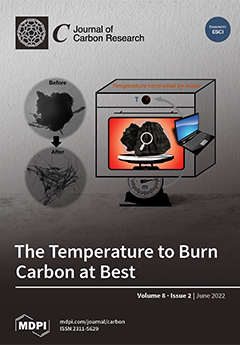Carbon-based materials (CBMs) such as graphene, carbon nanotubes (CNT), highly ordered pyrolytic graphite (HOPG), and pyrolytic carbon (PyC) have received a great deal of attention in recent years due to their unique electronic, optical, thermal, and mechanical properties. CBMs have been grown using
[...] Read more.
Carbon-based materials (CBMs) such as graphene, carbon nanotubes (CNT), highly ordered pyrolytic graphite (HOPG), and pyrolytic carbon (PyC) have received a great deal of attention in recent years due to their unique electronic, optical, thermal, and mechanical properties. CBMs have been grown using a variety of processes, including mechanical exfoliation, pulsed laser deposition (PLD), and chemical vapor deposition (CVD). Mechanical exfoliation creates materials that are irregularly formed and tiny in size. On the other hand, the practicality of the PLD approach for large-area high-quality CMB deposition is quite difficult. Thus, CVD is considered as the most effective method for growing CBMs. In this paper, a novel pulsed laser-assisted chemical vapor deposition (LCVD) technique was explored to determine ways to reduce the energy requirements to produce high quality CBMs. Different growth parameters, such as gas flow rate, temperature, laser energy, and deposition time were considered and studied thoroughly to analyze the growth pattern. CBMs are grown on Si and Cu substrates, where we find better quality CBM films on Cu as it aids the surface solubility of carbon. Raman spectroscopy confirms the presence of high-quality PyC which is grown at a temperature of 750 °C, CH
4 gas flow rate of 20 sccm, a laser frequency of 10 Hz, and an energy density of 0.116 J/cm
2 per pulse. It is found that the local pulsed-laser bombardment helps in breaking the carbon-hydrogen bonds of CH
4 at a much lower substrate temperature than its thermal decomposition temperature. There is no significant change in the 2D peak intensity in the Raman spectrum with the further increase in temperature which is the indicator of the number of the graphene layer. The intertwined graphene flakes of the PyC are observed due to the surface roughness, which is responsible for the quenching in the Raman 2D signal. These results will provide the platform to fabricate a large area single layer of graphene, including the other 2D materials, on different substrates using the LCVD technique.
Full article


